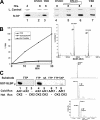Phosphorylation of threonine 61 by cyclin a/Cdk1 triggers degradation of stem-loop binding protein at the end of S phase
- PMID: 18490441
- PMCID: PMC2447125
- DOI: 10.1128/MCB.01416-07
Phosphorylation of threonine 61 by cyclin a/Cdk1 triggers degradation of stem-loop binding protein at the end of S phase
Abstract
Histone mRNA levels are cell cycle regulated, and a major regulatory mechanism is restriction of stem-loop binding protein (SLBP) to S phase. Degradation of SLBP at the end of S phase results in cessation of histone mRNA biosynthesis, preventing accumulation of histone mRNA until SLBP is synthesized just before entry into the next S phase. Degradation of SLBP requires an SFTTP (58 to 62) and KRKL (95 to 98) sequence, which is a putative cyclin binding site. A fusion protein with the 58-amino-acid sequence of SLBP (amino acids 51 to 108) fused to glutathione S-transferase (GST) is sufficient to mimic SLBP degradation at late S phase. Using GST-SLBP fusion proteins as a substrate, we show that cyclin A/Cdk1 phosphorylates Thr61. Furthermore, knockdown of Cdk1 by RNA interference stabilizes SLBP at the end of S phase. Phosphorylation of Thr61 is necessary for subsequent phosphorylation of Thr60 by CK2 in vitro. Inhibitors of CK2 also prevent degradation of SLBP at the end of S phase. Thus, phosphorylation of Thr61 by cyclin A/Cdk1 primes phosphorylation of Thr60 by CK2 and is responsible for initiating SLBP degradation. We conclude that the increase in cyclin A/Cdk1 activity at the end of S phase triggers degradation of SLBP at S/G(2).
Figures









Similar articles
-
DDB1 and CUL4 associated factor 11 (DCAF11) mediates degradation of Stem-loop binding protein at the end of S phase.Cell Cycle. 2016 Aug 2;15(15):1986-96. doi: 10.1080/15384101.2016.1191708. Epub 2016 Jun 2. Cell Cycle. 2016. PMID: 27254819 Free PMC article.
-
Phosphorylation of stem-loop binding protein (SLBP) on two threonines triggers degradation of SLBP, the sole cell cycle-regulated factor required for regulation of histone mRNA processing, at the end of S phase.Mol Cell Biol. 2003 Mar;23(5):1590-601. doi: 10.1128/MCB.23.5.1590-1601.2003. Mol Cell Biol. 2003. PMID: 12588979 Free PMC article.
-
Translation regulation and proteasome mediated degradation cooperate to keep stem-loop binding protein low in G1-phase.J Cell Biochem. 2014 Mar;115(3):523-30. doi: 10.1002/jcb.24686. J Cell Biochem. 2014. PMID: 24122909 Free PMC article.
-
Coordinate regulation of histone mRNA metabolism and DNA replication: cyclin A/cdk1 is involved in inactivation of histone mRNA metabolism and DNA replication at the end of S phase.Cell Cycle. 2010 Oct 1;9(19):3857-63. doi: 10.4161/cc.9.19.13300. Epub 2010 Oct 9. Cell Cycle. 2010. PMID: 20935461 Free PMC article.
-
Stem-loop binding protein and metal carcinogenesis.Semin Cancer Biol. 2021 Nov;76:38-44. doi: 10.1016/j.semcancer.2021.08.006. Epub 2021 Aug 18. Semin Cancer Biol. 2021. PMID: 34416372 Free PMC article. Review.
Cited by
-
The TRESLIN-MTBP complex couples completion of DNA replication with S/G2 transition.Mol Cell. 2022 Sep 15;82(18):3350-3365.e7. doi: 10.1016/j.molcel.2022.08.006. Epub 2022 Aug 31. Mol Cell. 2022. PMID: 36049481 Free PMC article.
-
How the cell cycle impacts chromatin architecture and influences cell fate.Front Genet. 2015 Feb 3;6:19. doi: 10.3389/fgene.2015.00019. eCollection 2015. Front Genet. 2015. PMID: 25691891 Free PMC article.
-
FEM1 proteins are ancient regulators of SLBP degradation.Cell Cycle. 2017 Mar 19;16(6):556-564. doi: 10.1080/15384101.2017.1284715. Epub 2017 Jan 24. Cell Cycle. 2017. PMID: 28118078 Free PMC article.
-
Replication stress-induced alternative mRNA splicing alters properties of the histone RNA-binding protein HBP/SLBP: a key factor in the control of histone gene expression.Biosci Rep. 2013 Sep 6;33(5):e00066. doi: 10.1042/BSR20130074. Biosci Rep. 2013. PMID: 23941746 Free PMC article.
-
Reversible proliferative arrest induced by rapid depletion of RNase MRP.Nat Commun. 2025 Jun 18;16(1):5342. doi: 10.1038/s41467-025-60471-4. Nat Commun. 2025. PMID: 40533478 Free PMC article.
References
-
- Archambault, V., N. E. Buchler, G. M. Wilmes, M. D. Jacobson, and F. R. Cross. 2005. Two-faced cyclins with eyes on the targets. Cell Cycle 4125-130. - PubMed
-
- Baldin, V., C. Cans, M. Knibiehler, and B. Ducommun. 1997. Phosphorylation of human CDC25B phosphatase by CDK1-cyclin A triggers its proteasome-dependent degradation. J. Biol. Chem. 27232731-32734. - PubMed
-
- Brown, N. R., M. E. Noble, J. A. Endicott, and L. N. Johnson. 1999. The structural basis for specificity of substrate and recruitment peptides for cyclin-dependent kinases. Nat. Cell Biol. 1438-443. - PubMed
Publication types
MeSH terms
Substances
Grants and funding
LinkOut - more resources
Full Text Sources
Other Literature Sources
Molecular Biology Databases
Research Materials
Miscellaneous
